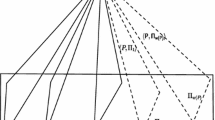Abstract
An (r,M,2δ;k)q constant-dimension subspace code, δ > 1, is a collection C of (k − 1)-dimensional projective subspaces of PG(r − 1,q) such that every (k − δ)-dimensional projective subspace of PG(r − 1,q) is contained in at most one member of C. Constant-dimension subspace codes gained recently lot of interest due to the work by Koetter and Kschischang [20], where they presented an application of such codes for error-correction in random network coding. Here a (2n,M,4;n)q constant-dimension subspace code is constructed, for every n ≥ 4. The size of our codes is considerably larger than all known constructions so far, whenever n > 4. When n = 4 a further improvement is provided by constructing an (8,M,4;4)q constant-dimension subspace code, with M = q12 + q2(q2 + 1)2(q2 + q + 1) + 1.
Similar content being viewed by others
References
A. Beutelspacher: Partial spreads in finite projective spaces and partial designs, Math. Z. 145 (1975), 211–229.
J. M. N. Brown: Partitioning the complement of a simplex in PG(e,q d+1) into copies of PG(d,q), J. Geom. 33 (1988), 11–16.
A. Cossidente and F. Pavese: On subspace codes, Des. Codes Cryptogr. DOI 10.1007/s10623-014-0018-6.
A. Cossidente, G. Marino and F. Pavese: Non-linear maximum rank distance codes, Des. Codes Cryptogr. DOI 10.1007/s10623-015-0108-0.
P. Delsarte: Bilinear forms over a finite field, with applications to coding theory, J. Combin. Theory Ser. A 25 (1978), 226–241.
R. H. Dye: Spreads and classes of maximal subgroups of GL(n,q), SL(n,q), PGL(n,q) and PSL(n,q), Ann. Mat. Pura Appl. 158 (1991), 33–50.
T. Etzion and N. Silberstein: Codes and Designs Related to Lifted MRD Codes, IEEE Trans. Inform. Theory 59 (2013), 1004–1017.
T. Etzion and N. Silberstein: Error-correcting codes in projective spaces via rankmetric codes and Ferrers diagrams, IEEE Trans. Inform. Theory 55 (2009), 2909–2919.
T. Etzion and A. Vardy: Error-correcting codes in projective space, IEEE Trans. Inform. Theory 57 (2011), 1165–1173.
E. M. Gabidulin: Theory of codes with maximum rank distance, Problems of Information Transmission 21 (1985), 1–12.
M. Gadouleau and Z. Yan: Constant-rank codes and their connection to constant-dimension codes, IEEE Trans. Inform. Theory 56 (2010), 3207–3216.
N. Gill: Polar spaces and embeddings of classical groups, New Zealand J. Math. 36 (2007), 175–184.
J. W. P. Hirschfeld: Finite projective spaces of three dimensions, Oxford Mathematical Monographs, Oxford Science Publications, The Clarendon Press, Oxford University Press, New York, 1985.
J. W. P. Hirschfeld and J. A. Thas: General Galois Geometries, Oxford Mathematical Monographs, Oxford Science Publications, The Clarendon Press, Oxford University Press, New York, 1991.
T. Honold, M. Kiermaier and S. Kurz: Optimal binary subspace codes of length 6, constant dimension 3 and minimum distance 4, Topics in finite fields 157–176, Contemp. Math. 632, Amer. Math. Soc., Providence, RI, 2015.
B. Huppert: Endliche Gruppen I, Die Grundlehren der Mathematischen Wissenschaften, Springer-Verlag, Berlin-New York, 1967.
A. Khaleghi, D. Silva and F. R. Kschischang: Subspace codes, Cryptography and coding 1–21, Lecture Notes in Comput. Sci., Springer, Berlin, 2009.
P. Kleidman and M. Liebeck: The subgroup structure of the finite classical groups, London Mathematical Society Lecture Note Series, vol. 129, Cambridge University Press, Cambridge, 1990.
A. Klein, K. Metsch and L. Storme: Small maximal partial spreads in classical finite polar spaces, Adv. Geom. 10 (2010), 379–402.
R. Koetter and F. R. Kschischang: Coding for errors and erasures in random network coding, IEEE Trans. Inform. Theory 54 (2008), 3579–3591.
M. Lavrauw and G. Van de Voorde: Field reduction and linear sets in finite geometry, Topics in finite fields, 271–293, Contemp. Math., 632, Amer. Math. Soc., Providence, RI, 2015.
G. Lunardon, G. Marino, O. Polverino and R. Trombetti: Maximum scattered linear sets of pseudoregulus type and the Segre Variety Sn;n, J. Algebr. Comb. 39 (2014), 807–831.
R. M. Roth: Maximum-rank array codes and their application to crisscross error correction, IEEE Trans. Inform. Theory 37 (1991), 328–336.
B. Segre: Teoria di Galois, fibrazioni proiettive e geometrie non desarguesiane, Ann. Mat. Pura Appl. 64 (1964), 1–76.
D. Silva, F. R. Kschischang and R. Koetter: A rank-metric approach to error control in random network coding, IEEE Trans. Inform. Theory, 54 (2008), 3951–3967.
A.-L. Trautmann and J. Rosenthal: New improvements on the echelon-Ferrers construction, in: Proc. of Int. Symp. on Math. Theory of Networks and Systems, 405–408, 2010.
S.-T. Xia and F.-W. Fu: Johnson type bounds on constant dimension codes, Des. Codes Cryptogr. 50 (2009), 163–172.
Author information
Authors and Affiliations
Corresponding author
Rights and permissions
About this article
Cite this article
Cossidente, A., Pavese, F. Subspace Codes in PG(2N − 1, Q). Combinatorica 37, 1073–1095 (2017). https://doi.org/10.1007/s00493-016-3354-5
Received:
Revised:
Published:
Issue Date:
DOI: https://doi.org/10.1007/s00493-016-3354-5




